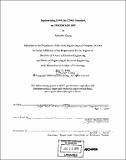| dc.contributor.advisor | Victor Michael Bove. | en_US |
| dc.contributor.author | Zhang, Xiaozhen, 1974- | en_US |
| dc.contributor.other | Massachusetts Institute of Technology. Dept. of Electrical Engineering and Computer Science. | en_US |
| dc.date.accessioned | 2006-05-15T20:22:51Z | |
| dc.date.available | 2006-05-15T20:22:51Z | |
| dc.date.copyright | 1999 | en_US |
| dc.date.issued | 1999 | en_US |
| dc.identifier.uri | http://hdl.handle.net/1721.1/32696 | |
| dc.description | Thesis (S.B. and M.Eng.)--Massachusetts Institute of Technology, Dept. of Electrical Engineering and Computer Science, 1999. | en_US |
| dc.description | Includes bibliographical references (leaf 73). | en_US |
| dc.description.abstract | IS-95 is the present U.S. 2nd generation CDMA standard. Currently, the 2nd generation CDMA phones are produced by Qualcomm. Texas Instruments (TI) has ASIC design for Viterbi Decoder on C54x. Several of the components in the forward link process are also implemented in hardware. However, having to design a specific hardware for a particular application is expensive and time consuming. Thus, the possibility of the alternative implementations is of great interest to both customers and TI itself. This research has achieved in successful implementation of IS-95 entirely in software on TI fixed-point DSP TMS320C6201, and met the real time constraint. IS-95 system, the industrial standard for CDMA, is a very complicated system and extremely computationally demanding. The transmission rate for an IS-95 system is 1.2288 Mcps. This research project includes all the major components of the demodulation process for the forward link system: PN Descrambling, Walsh Despreading, Phase Correction & Maximal Ratio Combining, Deinterleaver, Digital Automatic Gain Control, and Viterbi Decoder. The entire demodulation process is done completely in C. That makes it a very attractive alternative implementation in the future applications. It is well known that ASIC design is not only expensive and but also time consuming, programming in assembly is easier and cheaper, but programming in C is a much easier and efficient way out, in particular, for general computer engineers. During the whole process, efforts have been devoted on developing various specific techniques to optimize the design for all the components involved. These developments are successfully achieved by making the best use of the following techniques: to simplify the algorithms first before programming, to look for regularity in the problem, to work toward the Compiler's full efficiency, and to use C intrinsics whenever possible. All these attributes together make the implementation scheme great for DSP applications. The benchmark results compare very well to the TI-internal hand scheduled assembly performance of the same type of decoders. The estimated percentage usage of all the components (excluding PN) is only 21.18% of the total CPU cycles available (4,000 K), which is very efficient and impressive. | en_US |
| dc.description.statementofresponsibility | by Xiaozhen Zhang. | en_US |
| dc.format.extent | ix, 93 leaves | en_US |
| dc.format.extent | 4354207 bytes | |
| dc.format.extent | 4359864 bytes | |
| dc.format.mimetype | application/pdf | |
| dc.format.mimetype | application/pdf | |
| dc.language.iso | eng | en_US |
| dc.publisher | Massachusetts Institute of Technology | en_US |
| dc.rights | M.I.T. theses are protected by copyright. They may be viewed from this source for any purpose, but reproduction or distribution in any format is prohibited without written permission. See provided URL for inquiries about permission. | en_US |
| dc.rights.uri | http://dspace.mit.edu/handle/1721.1/7582 | |
| dc.subject | Electrical Engineering and Computer Science. | en_US |
| dc.title | Implementing IS-95, the CDMA standard, on TMS320C6201 DSP | en_US |
| dc.title.alternative | Implementing IS-95, the CDMA standard on TMS320C6201 digital signal processor | en_US |
| dc.type | Thesis | en_US |
| dc.description.degree | S.B.and M.Eng. | en_US |
| dc.contributor.department | Massachusetts Institute of Technology. Department of Electrical Engineering and Computer Science | en_US |
| dc.identifier.oclc | 43611370 | en_US |

